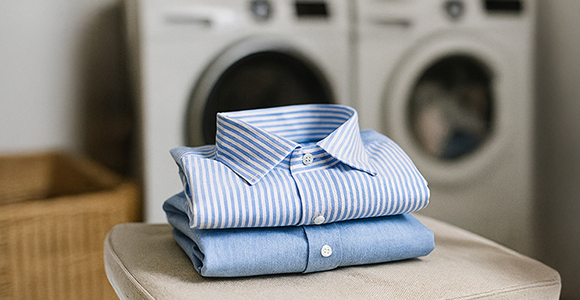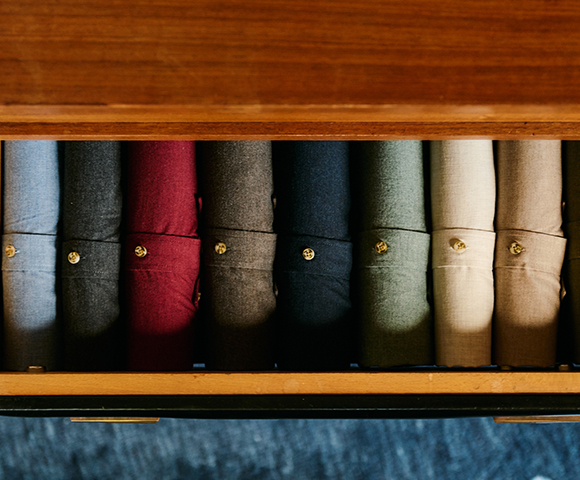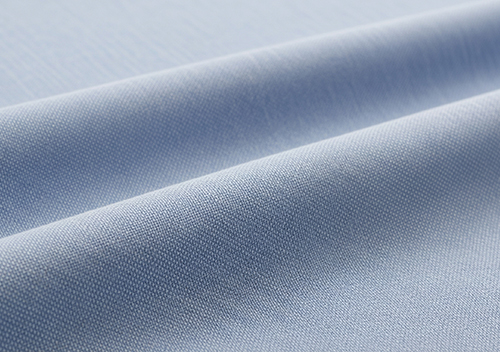- Home
- Guides and Tips
- Shirt Guide
- Shirt Care Guide
Caring for Your Bexley Shirts
Learn how to wash, iron, and store your cotton or linen shirts to extend their lifespan and maintain their elegance. Follow our tips for optimal and long-lasting fabric care.
Why is proper care so essential? In the world of men’s elegance, the shirt is a symbol of refinement. To keep your Bexley shirts looking sharp and lasting longer, careful maintenance is key. Beyond hygiene, caring for your shirts made from two-ply warp and weft fabrics helps preserve their quality over time.
The benefits of proper care: elegance and longevity. Following our shirt care advice ensures garments that stand the test of time. The right routine protects the weave, prevents premature fading, and keeps the fit impeccable. Taking care of your shirts also means enjoying the confidence of wearing a flawless piece each day—a true expression of timeless style.
1. How to Wash Your Shirt?
Sorting by Color and Fabric
Before washing, sort your shirts by color (white, light, dark) and fabric type (cotton, linen, wool, blends). This prevents color bleeding and helps adjust water temperature and wash cycle—key factors in preserving the textile fibers.
Preparing Collars, Cuffs and Buttons
Unbutton the collar, cuffs, and placket completely. Turn the shirt inside out to protect buttons and edges. This step helps preserve high-stress areas, ensures a thorough wash, and maintains the shirt's structure.

What Temperature Should You Wash a Shirt At?
- Cotton: wash at 30°C to 40°C.
- Cotton/Linen Blend: choose 30°C to 40°C on a delicate cycle to protect both fibers.
Bexley Tip: Always turn the shirt inside out before washing and use a detergent suitable for delicates or colored fabrics.

Should You Wash a Shirt by Hand or in a Machine?
Handwashing is the gentlest option, ideal for delicate fabrics. The “shirt” cycle on modern machines is suitable for fine fabrics if paired with a gentle spin (600 to 800 rpm).
Delicate Cycle and Recommended Products
Use a short, gentle cycle. Choose a liquid detergent without bleach or harsh softeners. For white shirts, add sodium percarbonate to brighten whites.
How Often Should You Wash a Shirt?
It depends on how you wear it. A shirt worn next to the skin should be washed after each use to prevent stains and odors. If worn over a t-shirt or only occasionally, washing after every two or three wears is sufficient.
How to Prevent Shirts from Wrinkling?
Do not overload the machine. Remove shirts quickly, shake them gently, and hang them immediately on a hanger. Avoid tumble drying, as it increases wrinkles and damages fibers.
Air drying in the shade on a hanger makes ironing easier.
Dealing with Specific Stains
Techniques for Removing Stubborn Stains
Act quickly: blot the stain with cold water, then apply a suitable stain remover (grease, wine, ink, etc.). For collars and cuffs, gently scrub with Marseille soap before washing. For stained or dull white shirts, soak them in a basin with sodium percarbonate and hot water to deep clean.
Avoid hot water on fresh stains—it may set them. Never use bleach, which weakens fibers and yellows the fabric.
Keeping White Shirts Bright
To maintain bright whites, wash separately and add 2 tablespoons of sodium percarbonate to your detergent. Occasionally, you can also add baking soda or a few drops of white vinegar. Always dry in the shade to prevent yellowing from sunlight.
2. Drying: Preserving the Quality of Your Shirts
Why You Should Avoid the Tumble Dryer
The tumble dryer accelerates fiber wear, increases shrinkage, and causes deep wrinkles that are hard to remove. Instead, choose natural air drying, which is gentler on the fabric’s structure and helps extend the life of your shirts.
Techniques for Optimal Hanger Drying
As soon as the wash cycle is complete, hang the shirt on a wide hanger—preferably made of wood or thick plastic—to maintain the collar and shoulder shape. Button the collar and a few buttons on the placket to prevent distortion. Dry in a well-ventilated room, away from direct sunlight.
Tips to Minimize Wrinkles While Drying
Gently shake the shirt before hanging to help relax the fibers. Smooth the collar, cuffs, and seams by hand while still damp. This reduces ironing time and keeps your shirt looking sharp day after day.
3. Ironing: The Art of a Perfect Shirt
How to Iron a Shirt Correctly and Easily?
Ironing a shirt enhances its tailoring and elevates its look. It’s best to iron it while slightly damp: fibers are more flexible and the result is cleaner. Use a clean iron or steam generator to avoid stains.
Make sure your ironing board is smooth and flat to prevent imprinting creases on the fabric.

Recommended Ironing Order
- Collar: open it, iron the back then the front gently.
- Shoulders: place one shoulder on the narrow end of the board and smooth gently.
- Sleeves: start with the cuffs, then lay the sleeve flat and avoid sharp creases.
- Front panels: avoid pressing on the buttons, iron around them carefully.
- Back panel: finish with the back by gliding the iron slowly.
Tip: fold or hang your shirt right after ironing to maintain a crisp finish.
Ironing Temperatures by Fabric Type
- Cotton: 150 °C to 200 °C with moderate steam. Lightly moisten if heavily wrinkled.
- Cotton/Linen blend: start at 180 °C, increase if needed. Use abundant steam if necessary.
Bexley Tip: Iron shirts inside out or use a pressing cloth to avoid shiny marks.

4. Shirt Storage
Hanging or Folding: Which Method to Choose?
Hanging on a hanger maintains the shape and prevents creasing—especially for cotton or linen shirts. If space is limited or during travel, fold carefully: align the collar neatly and fold the sleeves without pressing too tightly.
Tips to Avoid Wrinkles in the Closet
- Space hangers out to let each shirt breathe.
- Use hangers suited to shoulder width.
- Don’t overcrowd the closet to allow air circulation.
Wrinkle-Free Travel: Packing Tips
For crease-free travel, use individual covers or gently roll the shirt after folding. Place it on top of heavier clothes in your suitcase. Upon arrival, hang it up immediately: steam from a hot bathroom can naturally smooth out wrinkles.

 30 days
30 days 3D SECURE
3D SECURE

